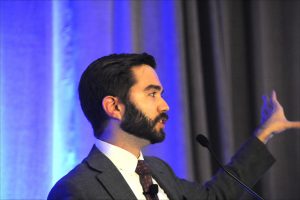Rare Disease Patient Groups Unite to Preserve Orphan Drug Tax Credit in US

The National Organization for Rare Disorders (NORD) says it’s “disappointed and dismayed” after the House of Representatives voted 227-205 last week to repeal the Orphan Drug Tax Credit as part of a U.S. tax reform package.
A similar package before the Senate Finance Committee does not repeal the credit entirely, but cuts incentives nearly in half by lowering its value from 50 percent of qualified clinical testing expenses to 27.5 percent.
A statement signed by 91 patient organizations under the NORD umbrella noted that without the Orphan Drug Tax Credit, new therapies for rare disease patients could tumble by more than a third.
“We will not stand idly by as Congress deliberates on diminishing the hope of the 95 percent of individuals with a rare disease still waiting for their very first treatment,” the petition, released Nov. 20, reads. “Any proposal that stands in their way to finally obtaining a safe and effective therapy is unacceptable.”
Dozens of groups ranging from the Alport Syndrome Foundation and the ALS Association to the Consortium of Multiple Sclerosis Centers, Parent Project Muscular Dystrophy and the Friedreich’s Ataxia Research Alliance endorsed the statement.
NORD, a nonprofit organization formed in 1983 — the same year President Reagan signed the Orphan Drug Act into law — says the tax incentives this law offers to U.S. pharmaceutical companies are crucial in spurring the development of new therapies.
The New York Times reported Nov. 8 that the tax credit — whose elimination could save the government an estimated $54 billion over the next decade — “has come under scrutiny because critics say that some major drugmakers have exploited it by obtaining the orphan designation for billion-dollar blockbuster drugs like Humira for treating rheumatoid arthritis and Crestor, the cholesterol drug, that were already on the market.”
But a study commissioned by NORD and released Oct. 17 during the organization’s Rare Diseases & Orphan Products Breakthrough Summit in Washington, D.C., found that approved drugs for orphan indications accounted for only $36 billion, or 7.9 percent, of the $460 billion Americans spent on pharmaceuticals in 2016.
According to the 32-page report, “Orphan Drugs in the United States: Providing Context for Use and Cost,” the median annual cost for an orphan drug in 2016 came to $32,880, but the 10 therapies used most by patients averaged $14,909.
Speaking at the summit, Paul Melmeyer, NORD’s director of federal policy, said the tax credits enshrined in the 1983 act have led to the approval of 451 orphan drugs for 590 rare disease indications since its passage.
“There is still a ton of misinformation out there on what the Orphan Drug Act does and does not do. If the orphan drug tax credit were repealed, we’d see one-third fewer drugs going forward, so we’re trying to do our best to emphasize to Congress how important this tax credit is to our rare disease community,” he said. “We believe that’ll be one of the most important roles we’ll be playing over the course of the next 12 months.”
State legislation also of concern
While the Orphan Drug Act has certainly grabbed headlines, it’s not the only legislative issue on NORD’s radar screen.
“NORD was incredibly active this summer fighting harmful changes to the Affordable Care Act,” said Tim Boyd, the organization’s director of state policy. “The changes that were being proposed were very harmful. This will continue to be a priority for us.”
In fact, various proposals at the state level concern the rare disease community as well, especially when they reportedly conflict with guidelines set by the U.S. Food and Drug Administration (FDA).
One example, say NORD officials, is the Massachusetts 1115 Waiver program. This program expands MassHealth — the state Medicaid program — to low-income families, but rations medicines to children and the elderly.
“We have recently seen a disturbing trend where states are ignoring what the FDA says about drug safety and effectiveness,” Boyd said. “This has resulted in rising out-of-pocket costs for drugs, patients getting substandard treatment, or no treatment at all.”
The 1115 Waiver could “potentially limit access to new and innovative” FDA-approved therapies made possible through the 21st Century Cures Act, which Congress approved in December 2016 with widespread bipartisan support.
“Restricting MassHealth’s drug benefits to a closed formulary would limit the ability of providers to make the best medical decisions for the care of their patients, effectively taking the clinical care decisions away from the doctor and patient, and giving it to the state,” stated an Oct. 18 letter to Eric Hargan, acting secretary of the U.S. Department of Health and Human Services. The letter was signed by NORD and more than 100 other advocacy groups.
Other “states to watch” when it comes to the 21st Century Cures Act, said Boyd, include Minnesota, New Jersey and Oregon.
“We find that many decisions about utilization are made without allowing patients to weigh in,” he said. “We believe states are making decisions about who gets a drug and who doesn’t, without consulting experts in the field about these diseases. This is really disturbing to us.”
Other priorities
Other priorities include increased federal funding for newborn rare disease screening programs, and expanding insurance coverage for medical foods.
To that end, Melmeyer said NORD supports the creation of an Office of Patient Affairs, as well as passage of a Medical Nutrition Equity Act.
“Currently, insurance coverage for medical nutrition is awful. We need to cover it. It’s medically necessary,” he said. “We must also improve access to pre-approval therapies. Right now, we have an expanded access program which is working for a lot of people, but we think it could work for even more people.”
Another hot-button issue is so-called “Right To Try” legislation, which allows terminally ill patients to try therapies that have passed the FDA’s Phase 1 clinical trial process but are not yet commercially available. So far, 37 states have passed Right To Try laws; several others are considering similar legislation.
According to the Phoenix-based Goldwater Institute, more than one million Americans die from terminal illnesses every year, yet fewer than 3 percent gain access to investigational treatments through clinical trials.
“Compassionate use exceptions are only granted to about 1,000 patients a year,” says a fact sheet on the institute’s website. “Many patients run out of time before they can qualify for the exemption … Right To Try laws help patients gain immediate access to the medical treatments they need before it’s too late.”
Said Melmeyer: “Our goal is to expand access to investigational therapies for those who do not qualify. But it’s not the FDA withholding access, it’s the companies.”
FDA Commissioner Scott Gottlieb weighed in on the issue at the NORD summit.
“We are fully committed to the goals of getting patients earlier access when they’ve exhausted other options,” said Gottlieb, a keynote speaker at the summit. “But there are various obstacles. There just isn’t product available in many cases because of manufacturing issues. Companies are using batches developed just for the purpose of clinical trials that have to be rationed, even in a pre-approval setting.”
Martha Rinker, NORD’s vice president of policy, said she expects two or three hearings on this topic, but Right to Try “is probably not going to see legislation on the federal level.”
Melmeyer advised the many patient advocates attending NORD’s event to “get to know the individuals at the FDA” who can help organizations navigate federal bureaucracy — and to keep pressure on Congress to do what’s right for the estimated 30 million Americans with rare diseases.
“All the folks who called their congressmen, tweeted or sent that email, made that video or Facebook post, they were so effective,” he said of past efforts. “It was the perfect testament to the power of advocacy — and why we need to be involved.”









Leave a comment
Fill in the required fields to post. Your email address will not be published.